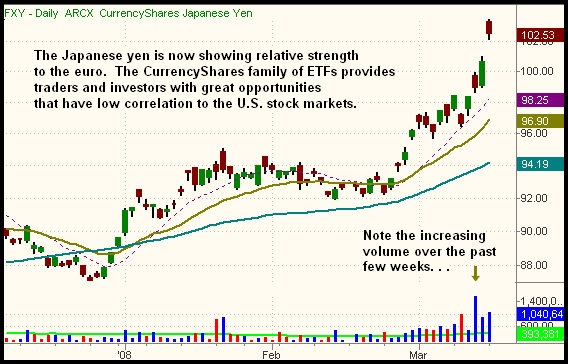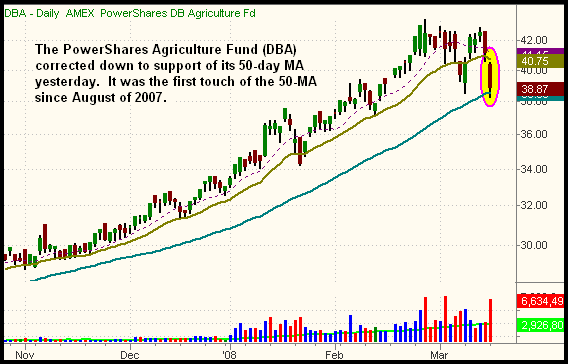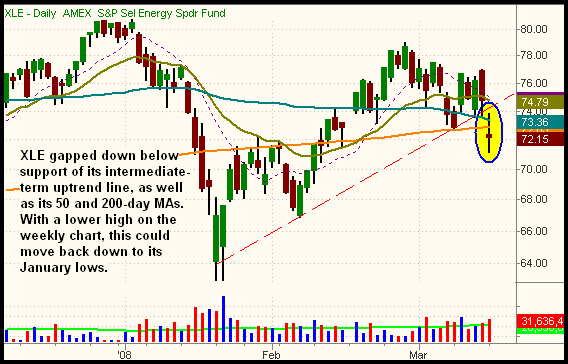|
The Wagner Daily ETF Report for March 18
The Bear Stearns news over the weekend caused trading to get off to a scary start yesterday morning, but the market quickly stabilized. After opening approximately 2% lower, the major indices valiantly attempted to reverse throughout the morning. The bears arrived at mid-day, sending the broad market back to new intraday lows, but the bulls returned in the afternoon. By the closing bell, the major indices had settled with mixed results. Blue chips showed relative strength, enabling the Dow Jones Industrial Average to eke out a 0.2% gain. The S&P 500 lost 0.9% and the Nasdaq Composite fell 1.6%. Small and mid-cap stocks lagged behind. The Russell 2000 and S&P Midcap 400 indices slid 1.9% and 2.1% respectively. Confirming yesterday's indecision, the main stock market indexes closed near the middle of their intraday ranges.
Turnover was mixed. Total volume in the NYSE increased 10% over the previous day's level, while volume in the Nasdaq receded 6%. Despite the positive close in the Dow, market internals across the board were firmly negative. Declining volume exceeded advancing volume by a margin of just over 3 to 1 in both the NYSE and Nasdaq.
Over the past several weeks, we've highlighted various commodities ETFs that have a low correlation to the direction of the overall stock market. If you're seeking additional opportunities for ETFs that trade largely independent of the main stock market indexes, don't forget about the CurrencyShares family of ETFs. You may already be familiar with the CurrencyShares Euro Trust (FXE), which mirrors the price of the euro compared to the U.S. dollar. Since breaking out of a 4-month base in late February of this year, FXE has zoomed to new highs every week. However, don't forget to check the chart patterns of other currencies in that ETF family as well. The CurrencyShares Japanese Yen (FXY), for example, has also been on a tear. Recently, it's even begun showing relative strength to the euro. Note the bullish gap to a new all-time high on the FXY daily chart below:

Along with the euro and yen, the Swiss franc (FXF) has ripped to a new high. In our opinion, these ETFs are now too extended for new long entry at current levels. Still, keep an eye on them when they begin to pull back. For a complete list of the available CurrencyShares ETFs, download our free Morpheus ETF Roundup, which will be updated to include other new ETFs within the next month or so.
Commodity ETFs, the only group of ETFs that have ignored the stock market's weakness in recent months, corrected sharply yesterday. A nice pullback to support of their primary uptrend lines and/or 20-day moving averages may provide us with low-risk entry points on the buy side. However, those who are already positioned in the commodity ETFs may wish to take profits, or at least trail very tight stops now. Since the commodity ETFs and the value of the U.S. dollar have had an inverse relationship lately, the pullback in commodity ETFs may be preceding an upcoming bounce in the dollar. If that occurs, we can expect the above currency ETFs to correct significantly too.
Yesterday's pullback in the silver (SLV) and gold (GLD) commodity ETFs was minimal. Both continue to hold very near their all-time highs, and well above their 20-day EMAs. But the PowerShares Agriculture Fund (DBA) dropped all the way down to its 50-day MA. Since its uptrend has been so strong, it was the first time DBA has even touched its 50-day MA since last August. This is shown below:

In addition to the agriculture ETFs, the U.S. Oil Fund (USO) and U.S. Natural Gas Fund (UNG) both corrected significantly off their highs yesterday. Because they're still so close to their highs, there's little price resistance to prevent them from quickly moving back up. As such, we do not recommend selling short USO or UNG. Since the stocks within a sector do not always trade in sync with the associated commodity, several energy ETFs comprised of oil and gas stocks are actually poised to break key support and roll over. The S&P Energy SPDR (XLE), for example, sliced below support of both its 50 and 200-day moving averages yesterday:

Not only did XLE close below two pivotal moving averages, it also fell below support of its intermediate-term uptrend line off the January 2008 low. On the long-term weekly chart, it also formed a "lower high" when the February high ran out of gas before moving back to the prior high from early January. This tells us that short, intermediate, and long-term trends are all favorable for short entry. With a plethora of overhead supply to contend with, we now like XLE for short entry below yesterday's low. Other ETFs comprised of energy stocks have similar patterns. The Oil Service HOLDR (OIH), iShares Energy (IYE), Vanguard Energy (VDE). If you have a non-marginable cash account, the inversely correlated UltraShort Oil and Gas ProShares (DUG) can be considered for long entry. Regular subscribers to The Wagner Daily should note our detailed trigger, stop, and target prices for the DUG setup below. Note that its chart pattern is basically a mirror image of XLE.
As for the broad market, there's not much to say until we see the reaction to this afternoon's Federal Reserve Board meeting on economic policy at 2:15 pm ET. As always, expect high volatility and whippy trading conditions immediately following the announcement. Consider having a list of both buy and short selling candidates for possible entry late in the day. Being prepared for a post-Fed reaction in either direction is the smart way to play it.
Open ETF positions:
Long - (none)
Short - (none)
Deron Wagner is the Founder and Head Trader of both Morpheus Capital LP, a U.S. hedge fund, and Morpheus Trading Group, a trader education firm launched in 2001 that provides daily technical analysis of the leading ETFs and stocks. For a free trial to the full version of The Wagner Daily or to learn about Wagner's other services, visit MorpheusTrading.com or send an e-mail to deron@morpheustrading.com.
|